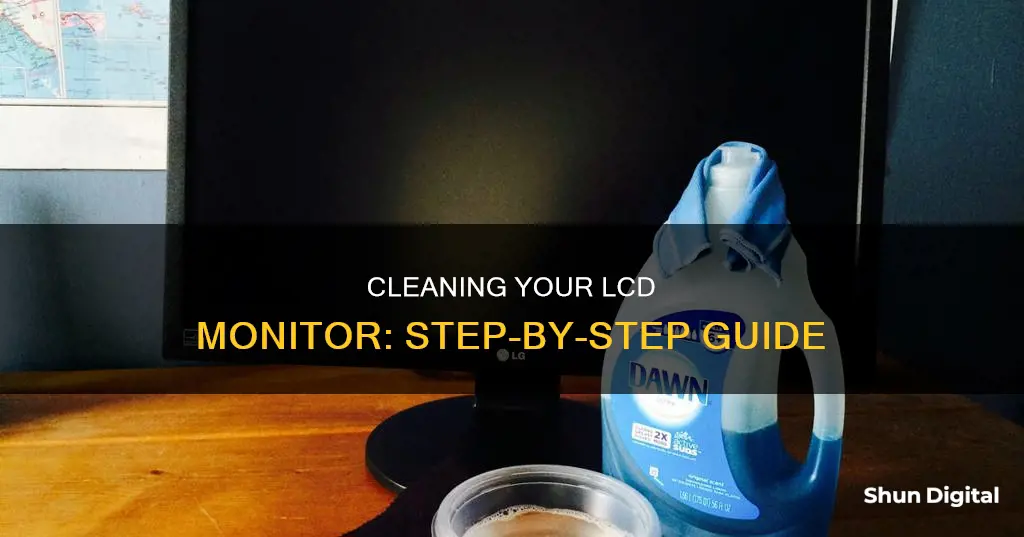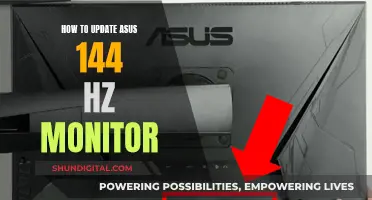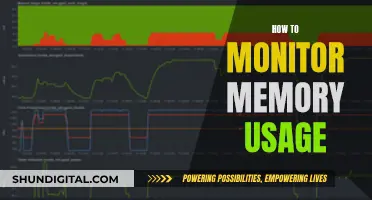
Keeping your LCD monitor clean is essential for optimal performance and to prevent damage. While a dry microfiber cloth is often enough to remove dust and minor smudges, you may need to use a dampened cloth or specialised cleaning products for stubborn marks. Before cleaning, it is important to turn off and unplug your monitor to avoid accidental damage and to make smudges and dust easier to spot. It is also recommended to check your device's user manual for any specific instructions or warnings.
How to wipe an LCD monitor
| Characteristics | Values |
|---|---|
| Cloth type | Microfiber, lint-free, non-abrasive |
| Cloth motion | Smooth, broad strokes |
| Cloth moisture | Damp, not wet |
| Cloth application | Gently |
| Screen state | Off, unplugged |
| Liquid use | Check user manual first |
| Liquid type | Water, vinegar, Lysol, LCD cleaner |
| Liquid application | Spray on cloth, not screen |
What You'll Learn

Microfibre cloths for dusting
Microfibre cloths are an essential tool for dusting LCD monitors. They are lint-free and gentle, making them ideal for this task. When dusting an LCD screen, it is important to first turn off the monitor to prevent any potential pixel damage.
Microfibre cloths are highly effective at removing dust and minor smudges from LCD screens. Their lint-free and non-abrasive properties make them a safer option than regular cloths or paper towels, which can be surprisingly harsh and damaging to screens. The soft and non-linting weave of microfibre cloths enables them to wipe smooth surfaces clean without leaving streaks.
Microfibre cloths can be used dry or slightly dampened with plain water. When dampening a microfibre cloth, it is important to wring it out thoroughly before wiping the screen gently with smooth, broad strokes. This process can be repeated as you work your way down the screen.
Microfibre cloths are also useful for removing stubborn smudges and stuck-on debris from LCD screens. For this, you may need to dampen the cloth with a vinegar and water solution or a mild dish soap and water mixture. It is important to check the user manual first to ensure that using liquids on your LCD screen is safe.
Microfibre cloths are a versatile and effective tool for keeping your LCD monitor dust and smudge-free. They are gentle, reusable, and can be used either dry or damp, making them a handy and essential item for LCD screen cleaning.
ViewSonic VA1938wa-LED: Does it Have HDMI?
You may want to see also

Vinegar and water solution
To clean an LCD monitor with a vinegar and water solution, you will need to mix equal parts distilled white vinegar and plain water in a bowl. Then, moisten a lint-free cloth (like a microfibre cloth) with the solution and wring it out. Starting at the top, wipe the cloth along the screen from one side to the other using broad, smooth strokes. Repeat this process as you work your way to the bottom of the screen.
Vinegar has sanitising properties, so it may kill some germs on the surface. However, keep in mind that this probably won't be as effective as using disinfectant wipes.
Before you start, make sure to power down the monitor and unplug the device to avoid damage. Also, check your device's user manual before using liquids on LCD screens.
Setting Up Your ASUS Monitor to 144Hz: A Step-by-Step Guide
You may want to see also

Pre-moistened wipes
- Power down your LCD monitor and unplug the device to avoid any potential damage. It is also easier to identify dirt and smudges on a black screen.
- Check the user manual or manufacturer's instructions for your specific LCD monitor model. Some screens may have special coatings or materials that require specific cleaning products or techniques.
- Choose a high-quality pre-moistened wipe that is designed for cleaning electronic devices. Look for options that are non-abrasive, lint-free, and quick-drying. Ensure the wipes are suitable for LCD screens and will not damage any coatings.
- Gently wipe the screen with the pre-moistened wipe, using smooth or circular motions from top to bottom. Avoid applying too much pressure, especially on touchscreens, as it may cause damage.
- Allow the screen to air dry completely before turning the device back on. This helps prevent moisture damage to the internal components.
- For regular maintenance, use a dry microfiber cloth to dust the screen gently. This can help reduce the need for frequent deep cleaning with pre-moistened wipes.
Asus 360Hz Monitor: Release Date and Specs
You may want to see also

Dish soap and water solution
Step 1: Power Down the Monitor
Before you begin cleaning your LCD monitor, it is important to power down the device and unplug it from its power source. This will help prevent damage to the screen and reduce the risk of electric shock.
Step 2: Gather Your Materials
For this cleaning method, you will need the following:
- A bowl of plain water
- Mild dish soap
- Lint-free microfiber cloths (at least two)
Step 3: Prepare the Cleaning Solution
Mix a small amount of mild dish soap with water in a bowl. You only need a few drops of dish soap—too much can leave a residue on the screen. The exact amount of dish soap to use will depend on the size of your bowl and the severity of the dirt on your screen. Start with a small amount and adjust as needed.
Step 4: Wipe the Screen
Dip one of your lint-free microfiber cloths into the soapy water solution and wring it out thoroughly. You want the cloth to be damp, not dripping wet. Gently wipe the screen using long, smooth strokes, working from the top of the screen to the bottom. Avoid applying too much pressure, as this can damage the LCD surface.
Step 5: Rinse and Wipe Again
Rinse the cloth with water to remove any soap residue, then wring it out again. Go over the screen a second time to ensure that all soap residue is removed.
Step 6: Dry the Screen
Allow the screen to air dry, or gently wipe it with a dry microfiber cloth to remove any remaining moisture. It is important to ensure that the screen is completely dry before powering the device back on to avoid the risk of damage or electric shock.
Additional Tips:
- Always refer to your device's user manual before using any liquids or cleaning solutions on an LCD screen. Some manufacturers may have specific instructions or restrictions.
- Avoid spraying liquid directly onto the screen, as this can cause liquid to seep into the edges of the screen and potentially cause damage.
- If possible, use distilled water instead of tap water, as it does not contain minerals that can be left behind on the screen.
- If you are looking for a more natural cleaning solution, a mixture of equal parts distilled white vinegar and water can be used as an alternative to dish soap and water.
- For regular dusting of your LCD screen, a dry microfiber cloth is usually sufficient and is a safer option.
Overclocking Your ASUS Monitor to 75Hz: A Step-by-Step Guide
You may want to see also

Commercial LCD cleaner
- Best Buy essentials BE-HCL301 LCD Screen Cleaning Kit: This kit includes a 6.7 oz. (200 ml) bottle of alcohol- and ammonia-free solution and an 8 x 6 inch microfiber cloth. It is designed to keep your screens clean and streak-free.
- AudioQuest CleanScreen Cleaner Kit: This kit includes a 6-oz. bottle of cleaning solution and a microfiber cloth. The solution is designed to safely smooth and buff the surface of view screens while reducing static.
- Insignia NS-PCYL550 5 oz. Screen Cleaning Solution: This eco-friendly solution is free of alcohol and ammonia and effectively removes dust, dirt, and fingerprints. It comes with a microfiber cloth and a StorDry bottle design to keep the cloth dry and mildew-free.
- MiracleWipes for Electronics Cleaning: These wipes are designed for TVs, phones, monitors, and other electronic devices. They come in a pack of 30 and include a microfiber towel.
- Screen Cleaner Spray Kit: This kit includes a 16 oz. bottle of cleaning solution and two microfiber cloths. It is suitable for LED and LCD screens, as well as other electronic devices.
Remember to always check your device's user manual before using any type of liquid or cleaner on your LCD screen. Some manufacturers may caution against using certain types of liquids or cleaners.
Monitoring Internet Usage on iPads: A Comprehensive Guide
You may want to see also
Frequently asked questions
It is recommended to use a dry, soft, lint-free microfiber cloth to wipe the screen gently. You can also use a damp microfiber cloth to get rid of stubborn smudges and stuck-on debris. It is important to ensure that the device is turned off and unplugged before cleaning.
A microfiber cloth is recommended for cleaning LCD monitors as it is lint-free and gentle on the screen. Regular cloths, rags, paper towels, and T-shirts can be too abrasive and may damage the screen.
It is generally recommended to avoid using liquids or cleaning products on LCD screens as they can cause damage. However, if necessary, a mild solution of distilled water and white vinegar or a small amount of dish soap can be used. It is important to check the user manual or manufacturer's instructions before using any liquids or cleaning products.







